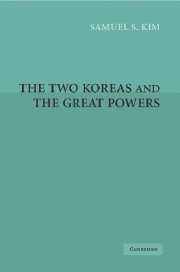Book contents
- Frontmatter
- Contents
- List of Tables and Figures
- Preface
- Chapter 1 Introduction: Korea and the Great Powers in a Changing World
- Chapter 2 China and the Two Koreas
- Chapter 3 Russia and the Two Koreas
- Chapter 4 Japan and the Two Koreas
- Chapter 5 The United States and the Two Koreas
- Chapter 6 The Future of the Two Koreas
- References
- Index
Chapter 1 - Introduction: Korea and the Great Powers in a Changing World
Published online by Cambridge University Press: 25 June 2009
- Frontmatter
- Contents
- List of Tables and Figures
- Preface
- Chapter 1 Introduction: Korea and the Great Powers in a Changing World
- Chapter 2 China and the Two Koreas
- Chapter 3 Russia and the Two Koreas
- Chapter 4 Japan and the Two Koreas
- Chapter 5 The United States and the Two Koreas
- Chapter 6 The Future of the Two Koreas
- References
- Index
Summary
A shrimp gets crushed to death in the fight between whales.
– An old Korean sayingHistorically, we Koreans have lived through a series of challenges and have responded to them. Having to live among big powers, the people on the Korean Peninsula have had to cope with countless tribulations. For thousands of years, however, we have successfully preserved our self-respect as a nation as well as our unique culture. Within the half-century since liberation from colonial rule, and despite territorial division, war, and poverty, we have built a nation that is the 12th largest economic power in the world.
– President Roh Moo-hyun's Inaugural Address, February 25, 2003The Three Koreas Revisited
The previous old Korean saying pithily captures the conventional realist wisdom about the security predicament of the weak in the region of the strong. Indeed, there is no mistaking the extraordinary ramifications of great-power rivalry for Korea's place in world affairs. For more than a century, and especially between 1894 and 1953, the Korean peninsula became a highly contested terrain that absorbed and reflected wider geopolitical struggles and even sanguinary wars involving, to varying degrees, imperial Japan, czarist Russia, the Soviet Union, Qing China, the People's Republic of China (PRC), and the United States – variations on the Big Four of contemporary Northeast Asian international relations.
- Type
- Chapter
- Information
- The Two Koreas and the Great Powers , pp. 1 - 41Publisher: Cambridge University PressPrint publication year: 2006

